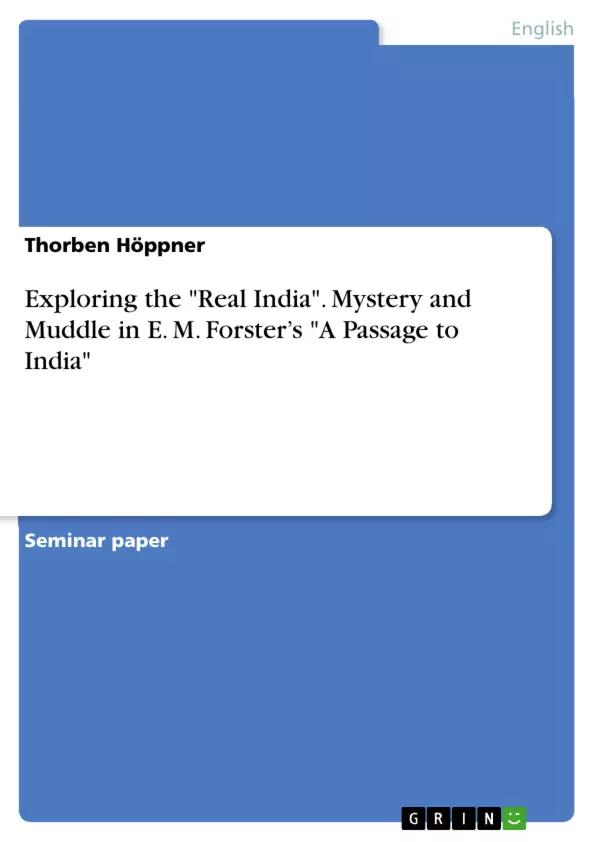The question arises, what the novel’s "A Passage to India" construction of India in the end suggests towards its own nature: muddle or mystery?
Consequently, this paper will investigate this question through analysis of the four main viewpoints of narratory comment, Cyril Fielding, Mrs. Moore, and Professor Godbole. This paper argues that the ‘real India’ of Forster’s novel is neither only muddle, nor solely mystery, but rather the fusion of the both, correlating with the Hindu Ideal of the unity of life which manifests itself in the mind of Professor Godbole. This paper then integrates the identified nature of the novel’s ‘real India’ into the discourse on Orientalist mysticism, which has famously been influenced by Edward Said.
Inhaltsverzeichnis (Table of Contents)
- Introduction: Muddle or Mystery? Searching for the ‘Real India'
- Muddled Mystery or Mysterious Muddle: Trying to Find the 'Real India' in A Passage to India
- "A muddle as we call it”: The Voice of the Narrator
- Cyril Fielding: A Captive "within the boundaries of the conscious text"
- 'Losing Her Religion': Mrs. Moore's “spiritual muddledom”
- "Come to me only": Professor Godbole as the Only True Survivor
- A Case of Orientalist Mysticism?
- Conclusion
Zielsetzung und Themenschwerpunkte (Objectives and Key Themes)
This paper aims to explore the imagery of muddle and mystery in E. M. Forster's novel A Passage to India, focusing on how these concepts are used to represent the 'real India'. The paper will examine the perspectives of key characters, including Mrs. Moore, Cyril Fielding, and Professor Godbole, to determine how their experiences shape their understanding of India.
- The role of the 'real India' as a key theme in the novel
- The use of the imagery of muddle and mystery to depict India
- The influence of different character perspectives on the understanding of muddle and mystery
- The relationship between muddle and mystery in shaping the novel's representation of India
- The connection between the 'real India' and the concept of Orientalist mysticism
Zusammenfassung der Kapitel (Chapter Summaries)
- The introduction explores the central question of the novel: how to grasp the 'real India'. It examines the characters' desire to understand a country that remains largely unknown to them, using the imagery of 'muddle' and 'mystery'.
- Chapter 2.1 delves into the narrator's voice and how it shapes the perception of India as a place of “muddle”. This chapter analyzes how the narrative voice reflects on the difficulties of understanding a country like India.
- Chapter 2.2 focuses on Cyril Fielding's perspective, exploring his experience as a British character caught "within the boundaries of the conscious text." This chapter examines how Fielding's understanding of India is shaped by his own cultural context and his attempts to navigate the complex social landscape.
- Chapter 2.3 analyzes Mrs. Moore's experience, focusing on her "spiritual muddledom." This chapter investigates how her journey through India leads her to question her own beliefs and confront the limitations of her understanding.
- Chapter 2.4 investigates the perspective of Professor Godbole, highlighting his role as the "Only True Survivor." This chapter explores how Godbole's understanding of India is rooted in a deeper spiritual connection to the country, transcending the limitations of Western perspectives.
Schlüsselwörter (Keywords)
Key terms and concepts explored in this paper include: muddle, mystery, Orientalist mysticism, the 'real India', character perspective, narratology, cultural understanding, spiritual connection, and Forster's A Passage to India. The paper examines these terms in relation to the representation of India in the novel, the challenges of understanding a foreign culture, and the interplay of different perspectives.
- Quote paper
- Thorben Höppner (Author), 2021, Exploring the "Real India". Mystery and Muddle in E. M. Forster’s "A Passage to India", Munich, GRIN Verlag, https://www.grin.com/document/1354994



